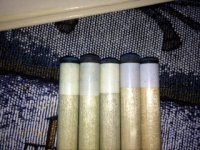So, can someone go through a list? Pie segments, generations, etc.
Not interested in the Steve Titus & Clawson Cue history, just the shaft evolution. I want to have a clue what I have.
Thanks,
Freddie <~~~ wondering when I got all of these shaft?
Fred,
As you know I worked there from early 1996 to late 2003 however my memory is not as good as it used to be but here is what I recall.
The first shafts made were LD and one piece in Clawson. They then figured out how to radially splice the shafts and started experimenting with 6 piece, 10 piece and 12 piece shafts. Iron Willie was used to determine which configuration was most radially consistent and it was determined that 10 was better than 6 but 12 was only slightly improved on 10 and too small of a difference for pool players to tell so they settled on 10. The 6 piece were not suggested to be better for breaking with, in fact it was recommended that you could break with any Predator shaft irrespective of the number of splices.
The original ferrules were 1". A change was made to 3/4" after a few years and iirc the logo was changed at that time from having just 314 on the 1 inch to having 314 with the cat on the 3/4". I do not believe that the ferrule material was changed when the length and logo was changed but I could be wrong. Predator also made a change internally on the shaft at that time. The hole was originally capped with a small plastic disk that was glued to the top of the tenon (this was to prevent ferrule glue from getting inside the hole). On occasion, the disk would move or not be installed correctly and on a completed shaft a piece of ferrule glue could break off and get inside the hole and create a rattle or buzzing noise which resulted in returns that required the ferrule to be removed and the hole cleaned out and the front end completed again. The plastic disks were then replaced with a foam material used to plug the front end prior to the ferrule being installed to reduce/eliminate the opportunity for ferrule glue to get inside the hole.
The switch to 3/4" ferrules did reduce the amount of cueball squirt as front end mass was reduced with the shorter ferrule. Eventually the Z shafts were added and later there was a further switch to even shorter ferrules on both shafts to further reduce cueball squirt which resulted in the 2nd generation 314-2 and Z-2 being born.
After I left Predator the 2nd generation shafts received a ferrule material change which did result in many returns as the ferrules were cracking way too easily. Predator eventually did a recall on all of these shafts which I am sure was a nightmare but as far as I could tell, they did everything in there power to fix this situation asap (although it took months) and eventually got back stock from most of their dealers and distributors and then made another ferrule material switch which is afaik the same material they use today.
Predator always made the shaft blanks themselves but would have other companies turn them. I believe they used Falcon (primarily), McDermott, Viking, Joss, Samsara to do the turning. However, none of these companies would ever be responsible for the ld work in the first 5 inches. Predator would send them 10 piece rough blanks and they would come back with the shaft turned, taper done, joint work and logo installed but the drilling of the hole in the front end and the installation of the ferrule and tip and final finish sanding and buffing was always done by Predator.
A decision was then made to stop manufacturing shaft blanks and finishing shafts in Jacksonville, Florida and move all of the production to China which is where all of the shafts are made today. I am not privy to any additional ferrule material changes or shaft front end construction changes since then beyond what I read on the forums and hear through the grapevine.
As far as timelines for all of the above, your guess is as good as mine. As stated, my memory is not what it used to be. I can however suggest that if you really want to know, then call Allan McCarty and he should be able to fill in some blanks for you (feel free to PM me for his cell if you would like to speak with him. I am sure he would be happy to talk with you about it)
Hope this helps Freddie.
